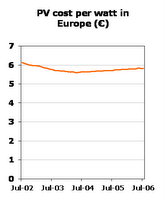The completely dreadful economics of solar power in Britain
 A flurry of news that Currys, the electrical retailer, is to sell solar photovoltaic panels to the public. The 'photovoltaic' (PV) panels generate renewable electricity from sunlight and displace carbon dioxide emissions generated in conventional power stations. Surely, an environmental success story? I think not... I've been a solar sceptic since the mid 1990s when Greenpeace was pitching that PV would be producing competitively priced electricity by 2000. It never happened. And it was never likely to.
A flurry of news that Currys, the electrical retailer, is to sell solar photovoltaic panels to the public. The 'photovoltaic' (PV) panels generate renewable electricity from sunlight and displace carbon dioxide emissions generated in conventional power stations. Surely, an environmental success story? I think not... I've been a solar sceptic since the mid 1990s when Greenpeace was pitching that PV would be producing competitively priced electricity by 2000. It never happened. And it was never likely to.
The Currys deal claims to be a bargain... but it looks like the offer is £9,000 for a 2KW system, and that certainly isn't a bargain for the user, or for the environment.
My inner-anorak reports that this £9000 investment will do the following:
- Produce electricity at a cost of 49 pence per KWh based on cost of money at 6% and 20 year life, no annual costs (like insurance) and only if installed in the perfect location (south-facing 30 degree inclination). That's about five times retail power prices and 12-15 times the cost of wind power generation.
- The investment of £9,000 of will displace mains electricity of 1600KWh. This is worth about £150 per year (based on the npower marginal retail price of 9.44 pence/KWh).In other words, it has a payback period of about 60 years (undiscounted).
- It will save some CO2 emissions, but not much and at great cost. Savings of about 688Kg per year will be achieved, but the cost per tonne of carbon dioxide reduced comes to about £920. 75 times the cost of emissions reductions in the EU emissions trading regime (about £12/tonne) and vastly more than saving the same energy.
- Just about the most expensive carbon reductions imaginable with poor return to the environment;
- Vanity-purchases for rich individuals and businesses seeking PR - or worse, the squandering of people's goodwill and desire to do something for the environment on a very poor investment;
- A distraction of effort and money away from doing the things that really deliver value for money, like saving energy - which usually reduces bills and protects the environment.
Why isn't PV cheaper? Despite years of promise that huge volumes would drive down the price, that doesn't appear to be happening (at least recently, see charts). Prices fell sharply in the 80s and early 90s, but over the last four years, prices have only come down by 4% (source). One of the often spouted misconceptions about PV is that it should have price-performance characteristics like semiconductor chips. But it just doesn't... the cost of a single memory chip hasn't come down that much, but the number of circuits on it has hugely increased, and with it the value for money. But megabytes and megawatts are very different... With PV, the best that can be achieved is that all of the light energy falling on the PV surface will become electricity, but there are thermodynamic limits and inefficiencies that stop the current designs coming close (see overview) - and minaturistaion cannot drive PV performance like it drives chip performance. There cannot be a Moore's Law for PV. At the current rate of progress - the trend in the graph above - it would take about 70 years for the module price to halve. More of the costs would become 'balance of system' (inverters, meters etc) and installation - which are unlikely to have great cost reductions in future.
Basically, PV is an expensive distraction in most circumstances in Britain and too far from being a competitive source of energy or cost-effective source of carbon reductions to make it worth investing in as a mainstream response to climate change or energy needs. It's main markets are in mopping up subsidies provided by governments, like ours (Low carbon buildings programme) and much larger schemes in Japan and Germany. But what is the public purpose of such subsidies?



2 comments:
Definitely food for thought, although I would expect the costs to come down substantially due to economies of manufacturing and shipping scale, not due to any technological improvement.
Have you seen the latest in hydrogen generation - this looks very promising:
http://www.newscientisttech.com/article.ns?id=dn10441&feedId=tech_rss20
Cheers
Simon.
Hmm yes PV is one of the least feasible tech's but solar thermal water heating on the other henad IS the 2nd best (viable) renewable technology after biomass! even in the UK!
Post a Comment